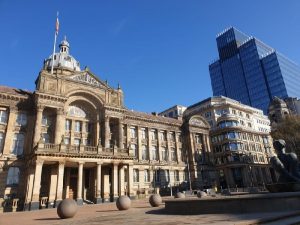Talking Business: Colin Bryan and Andrew Clayton, Drayton Manor Theme Park

In the latest in a series of ‘Talking Business’ interviews, Colin Bryan and Andrew Clayton of Drayton Manor Theme Park chat to the editor of TheBusinessDesk.com Andy Coyne, and KPMG partner Ian Greaves.
COMMENTInvestment and innovation is central to securing a share of the consumer wallet
|
SAVIOURS come in all shapes and sizes but not usually in the form of a blue railway engine with a Liverpudlian accent. But it was Thomas the Tank Engine who helped to change the fortunes of Drayton Manor Theme Park. Saviour may be over-egging the pudding but there was a realisation more than half a decade ago amongst senior management at the family-owned park near Tamworth that its attempts to compete with the likes of Alton Towers and Thorpe Park to bring ever more thrilling rides aimed at adrenaline junkies and teenagers might not be the best strategy to follow. It was hugely expensive and took the park into competition with rivals owned by multi-national leisure companies. By 2006 – pre the general recession – a drop off in visitor numbers suggested it wasn’t what people wanted. Drayton Manor CEO and group managing director Colin Bryan and finance director Andrew Clayton recall the moment well. Bryan – whose father George and mother Vera co-founded the theme park – says: “We started to have a decline in customers from 2006 onwards. It was very steep.” Clayton (below right) takes up the story. “We had become more involved in white knuckle rides and we were missing out on the family unit,” he says. “We were seen as a park for teenagers and young adults. So we decided we should see what we could do to make it a family park. “Research showed that a character-based approach would be useful.” So in March 2008 enter stage left Thomas the Tank Engine. Thomas Land was a £7m plus investment but, in Bryan’s words,“has given us a decent return in terms of visitors and more than neutralised the effects of the downturn”. In fact, the year after it was introduced visitor numbers rose by a massive 41%. And Bryan has no fears of it going out of fashion. “It’s a Mickey Mouse brand, it won’t go out of favour,” he said. “Thomas is the third largest toy brand in the world.” And because of the age of visitor Thomas Land attracts, its introduction has also given a new lease of life to the theme park’s zoo. But Clayton points out there are other factors to play in the park’s resurgence. “Consumer confidence has suffered and people have cut back on their leisure spend on things like holidays. So the ‘staycation’ has come into play,” he says. 2011 became another key year in the park’s development when a £18.5m 150 bedroom hotel opened with attached facilities for corporate events. Colin Bryan first had the idea in 1998 and it fair to say that his experience of the planning process has not over-impressed him. But he may have to go through the whole thing again as he and his executive team are considering a second hotel as well as lodges. The thinking is that the American idea of a ‘resort’ is what people are looking for now: a break where they can stay at the park, eat and drink at the park and enjoy the facilities. “You wouldn’t believe how many more foreign visitors we have been getting since the hotel has been up and running,” Bryan says. “We’ve always marketed ourselves far and wide but people appreciate that they can stay here.” Drayton Manor Resort is likely to be a name used in the future. But whatever you call them, theme parks will remain hungry beasts and their favoured diet is investment cash. Clayton says: “Visitor numbers and the hotel both drive profitability but you have to continue to invest. “People don’t always appreciate they cost of maintaining something like this and the tax burden. For every £1 we receive, 24p goes to the Government.” Bryan adds: “we only make 3p out of every pound.” “And that’s for re-investment,” says Clayton. That could be for new rides – the park tries to introduce something new every year – or in facilities such as the hotel. Because Alton Towers and Thorpe Park have stuck with their thrill rides approach – the metal – Drayton Manor (although not short in the thrill ride stakes itself) now finds itself increasingly in competition with the likes of Legoland, the Lego-based, family-oriented theme park near Windsor owned by leisure giant Merlin, which also owns Alton Towers, the Sea Life centres and the London Eye amongst other attractions. Drayton Manor is more than holding its own, attracting close to 1.5m visitors a year. But Bryan suggests that that the leisure tourism sector hasn’t been appreciated by successive governments. Leisure tourism, indeed tourism generally, which contributes a considerable amount to UK GDP, doesn’t have its own front bench minister. “It comes under sports even though it is the fourth largest industry in the UK,” Bryan says. “And the Government cut tourism funding just before the Olympics. “We’d like to have a level playing field and to see VAT reduced. Clayton adds: “It makes us far less competitive than rivals in Europe as an attraction and for accommodation costs because of the extra we have to pay.” And banks also need convincing about the worth of theme parks – even successful ones. Clayton says: “Borrowing is very much more tricky these days. The criteria for lending has changed. We obviously have to pay down the debt on the hotel but there is still a need to continue to invest.” And one thing that is on the minds of Bryan and Clayton as far as future investment is concerned is the aforementioned second hotel. There is certainly room as only 113 acres of the 280 acre site are currently being used. Bryan will be hoping that planning negotiations with Lichfield District Council will run more smoothly than the first time around. The council should be acutely aware that Drayton Manor is one of the largest employers in the area and another hotel will mean more jobs will be created in an area of high unemployment. To illustrate the level of demand, in January Drayton Manor had more than 1,000 applicants for 150 seasonal jobs. But perhaps with previous experience in mind, Bryan isn’t expecting anything to happen overnight. “Another hotel is in our five to seven year plan,” he says. SectorsCommentsIf you'd like to leave a comment, please register now for free or login
|













